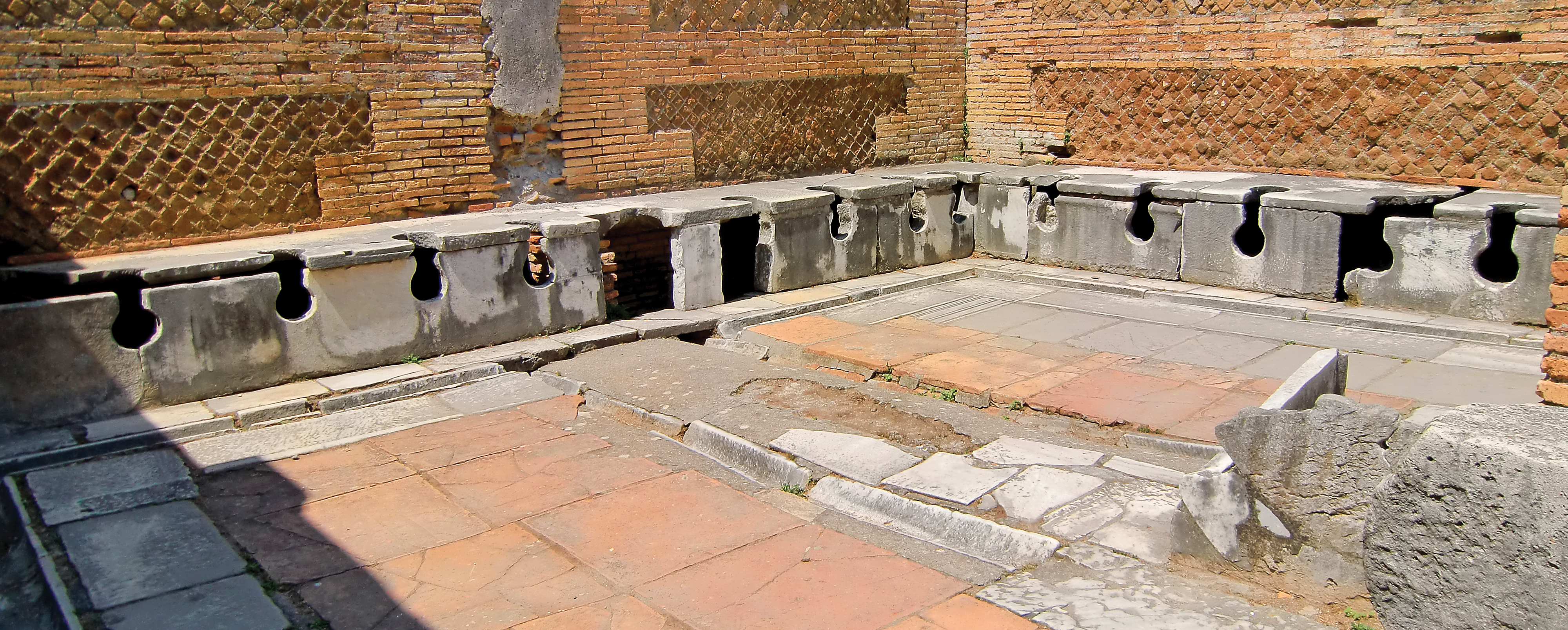Raising a Really Big Stink

Remnants of a public latrine built in Ostia.
by Ann Olga Koloski-Ostrow
The ancient Romans lived in smelly cities. We know this from archaeological evidence found at the best-preserved sites of Roman Italy — Pompeii, Herculaneum, Ostia and Rome — as well as from contemporary literary references.
When I say smelly, I mean eye-wateringly, pungently smelly. Even the entertainment reeked. Consider the carnage produced by the popular gladiatorial and animal blood-bath games. At Rome’s Colosseum, a system of ropes and pulleys could lift as many as 100 animals (such as leopards, lions, tigers and panthers) simultaneously to the arena’s surface. During the building’s first 100 days, in 80 C.E., a total of 9,000 animals were killed. The smells from the remains of games held in this or any other amphitheater must have been ghastly — a combination of blood, guts, dead men, dead animals and millions of flies gorging on all that flesh.
Open-air Roman markets presented their own version of this sensory assault. Amid the fragrant fresh fruits and piles of herbs, the displays of shellfish, fish and blood-red slabs of meat would have had no refrigeration, save for some occasional ice or snow from the mountains during the winter months. The fly-infested fish and meat quickly turned rancid. It’s no wonder Romans made liberal use of heavy fermented fish sauces to hide the multitude of sins blooming in deteriorating foods.
The smoke and smells of animal fat burning on open altars regularly filled the fora and nearby streets. Roman religious festivals required a daily blood sacrifice of at least one bull or some other animal, sometimes dozens of them. As the smells of burning beef filled the fora during the numerous festival days, the smells of human carcasses burning by the hundreds (by the thousands during plague periods) blemished the air each and every day — for centuries, the Romans cremated their dead just outside the main city gates.
Despite this foul-smelling atmosphere, the ancient Romans are widely admired for what appears to be an enormous commitment to hygiene and public health. We know they built vast sewer systems, such as the masterful Cloaca Maxima in Rome. And the gleaming Roman baths tourists still visit today present a vision of cleanliness and purity.
But my research has revealed that the Cloaca and other cities’ sewer systems weren’t constructed primarily for the removal of human waste. They were used to drain water that pooled on uneven streets or filled low-lying areas after river floods. This discovery altogether changes our ideas about the Romans’ perspective on health and sanitation. Sewers moved unbearably odoriferous water away from where it hindered cleanliness, economic growth, urban development or industry, but they did not contribute that much to urban sanitation.
Almost every house and apartment building in Pompeii, Herculaneum and Ostia (cities much better preserved than Rome) had private one-seat toilets, yet they were rarely connected to the main sewer lines. They tended to be cesspit toilets, which had to be emptied by hand (household slaves had the honor). The contents were either sold to farmers for fertilizer or used in household gardens.

Mike Lovett
Ann Olga Koloski-Ostrow
page 2 of 2
Why didn’t the Romans connect their toilets to the public sewers? For one thing, Roman sewers had no traps, so you never knew what might climb out of a sewer-connected loo. The Roman author Aelian writes of a wealthy Iberian merchant who, puzzled by the gradual disappearance of the pickled fish stored in his well-stocked pantry, discovered it was being eaten bit by bit every night by an octopus that came up through the toilet.
Multiseat public latrines, which were almost always connected to the main sewer lines, were notorious for terrifying customers. Flames sometimes burst from the seat openings, thanks to mephitic gas explosions that were rank as well as frightening. Rats and other small vermin threatened to bite the bottoms of toilet users.
According to archaeological evidence and 1st century C.E. medical texts, the public bath buildings offered their own health risks. In a steaming 12-person bathtub, you were very likely sitting next to someone suffering from open wounds, lesions, lice, gangrene, worms, diarrhea, gonorrhea, tuberculosis or worse. It boggles the mind to reflect on what the health outcomes of a single visit to a Roman bath could be.
The Romans did not understand that diseases could be spread via human and animal waste. While they certainly appreciated baths and cleanliness, they rarely connected bathing to broader issues of sanitation in their cities. They went to a Roman bath more for the social experience than for health reasons.
It’s clear that the lack of zoning for businesses and activities in ancient Rome knitted the rich and the poor rather tightly together in a smelly, unsanitary urban landscape. Vast quantities of animal dung, vomit, pee, shit, detritus, garbage and filthy water filled the streets. Inside tenement buildings were mold, dampness, charcoal fires, stagnant well water, and cesspits, often clogged. The smell of fire, smoke and odors from countless markets, shops and manufacturers permeated the air. In crowded fora and the amphitheater, the stench of death from blood sports mixed with the ever-present odors of burning sacrifices to the gods and the funeral pyres just outside city walls. Toilets and public baths were heavy with the smell of excrement, urine and disease.
In classical scholarship, when we sniff out what the nose knows, we reconstruct a vivid picture of daily life in Rome, one that reveals both the risks and the delights of that ancient society.
Ann Olga Koloski-Ostrow is the Department of Classical Studies chair.
